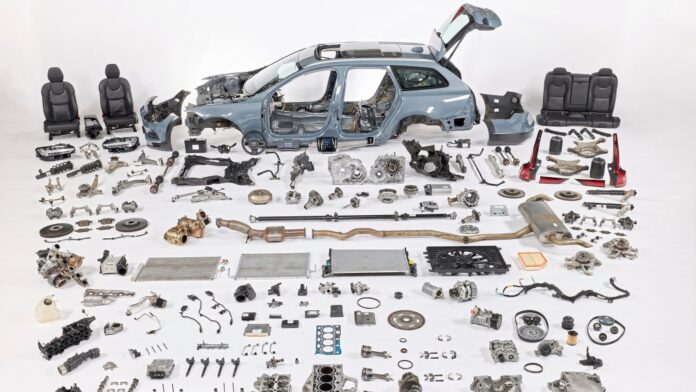“How reliable are our cars after enduring 100,000 kilometers?” This question looms large in the minds of many consumers, particularly as the automotive market evolves rapidly. With increasing competition and technological advancements, the durability of vehicles is more crucial than ever. A recent analysis reveals that only a select few models can withstand the rigors of long-term testing, raising concerns about the longevity of many popular choices. The stakes are high for manufacturers as consumers demand assurance that their investments will stand the test of time. The findings challenge the perception of reliability in modern vehicles: which models truly deliver on their promises?
As car buyers become more discerning, understanding vehicle performance over extended distances is vital. The exhaustive tests conducted by automotive experts provide critical insights into the durability of various models. However, not all cars perform equally, and the results can significantly influence consumer decisions. With the average American driver covering around 13,500 miles annually, a vehicle that can endure 100,000 kilometers—approximately 62,137 miles—becomes a benchmark for reliability. This article delves into the results of these rigorous tests, highlighting the top performers and what it means for potential buyers.
Understanding the Long-term Test Criteria
Long-term tests are designed to assess a vehicle’s durability, performance, and reliability over time. These assessments typically involve driving the vehicle under various conditions, including city traffic, highway speeds, and challenging terrains. Manufacturers often provide vehicles for these tests, but the evaluation remains independent to ensure objectivity. The primary criteria for these tests include engine performance, transmission efficiency, suspension integrity, and overall build quality.
During the testing phase, vehicles are subjected to a wide range of scenarios, from extreme weather conditions to heavy loads. This comprehensive approach allows testers to identify potential weaknesses that may not be apparent during short test drives. For example, issues such as engine overheating or transmission failure may only emerge after extensive use. By simulating real-world driving conditions, testers can provide valuable data on how well a vehicle will hold up over time.
The implications of these tests are significant for consumers. A vehicle that excels in long-term testing is likely to offer better resale value, lower maintenance costs, and greater peace of mind. As the automotive market becomes increasingly competitive, understanding these criteria can help buyers make informed decisions and choose models that will serve them well for years to come.
The Top Performers in Long-term Testing
After rigorous evaluations, several vehicles have emerged as top performers in long-term tests. These models demonstrate exceptional durability and reliability, making them ideal choices for consumers seeking a long-lasting investment. Notable mentions include brands renowned for their engineering excellence and commitment to quality.
For instance, one standout model has consistently ranked high due to its robust engine and minimal maintenance requirements. This vehicle not only offers impressive fuel efficiency but also boasts a reputation for longevity, with many owners reporting trouble-free experiences even after surpassing the 100,000-kilometer mark. Another model, known for its advanced technology and safety features, has also performed admirably, showcasing how innovation can complement durability.
The success of these vehicles in long-term tests underscores the importance of manufacturer commitment to quality. As consumers become more aware of the long-term implications of their purchases, manufacturers must prioritize durability to maintain market share. The ability to withstand extensive testing is not just a badge of honor; it is a vital selling point that can influence consumer choices significantly.
Consumer Implications and Market Trends
The results of long-term testing have far-reaching implications for consumers and the automotive market as a whole. As buyers become increasingly concerned about reliability, manufacturers are compelled to enhance their vehicles’ durability. This trend is evident in the growing emphasis on quality control during production and the adoption of advanced materials designed to withstand wear and tear.
Moreover, consumer feedback plays a crucial role in shaping market trends. With the rise of online reviews and social media, potential buyers have access to a wealth of information about the long-term performance of various models. This transparency encourages manufacturers to prioritize reliability and durability, knowing that their reputation is on the line.
As a result, the automotive landscape is evolving, with a shift towards vehicles that not only meet consumer demands for performance but also exceed expectations for longevity. This transformation is likely to continue as technology advances and consumer preferences shift, ultimately benefiting buyers seeking reliable transportation options.
The Future of Automotive Reliability
Looking ahead, the future of automotive reliability appears promising. With advancements in engineering and materials science, manufacturers are better equipped to produce vehicles that can withstand the rigors of long-term use. Innovations such as electric vehicles and hybrid technology are also influencing reliability standards, as these models often require less maintenance and offer improved efficiency.
Furthermore, as environmental concerns become more pressing, manufacturers are increasingly focusing on sustainable practices that enhance vehicle durability. This shift not only benefits consumers but also contributes to a more sustainable automotive industry. By prioritizing long-lasting vehicles, manufacturers can reduce waste and promote responsible consumption.
Ultimately, the results of long-term testing serve as a valuable benchmark for both consumers and manufacturers. As buyers seek vehicles that offer reliability and durability, manufacturers must rise to the occasion, ensuring that their offerings meet the demands of an increasingly discerning market. The automotive industry is at a crossroads, and the commitment to producing reliable vehicles will define its future trajectory.


